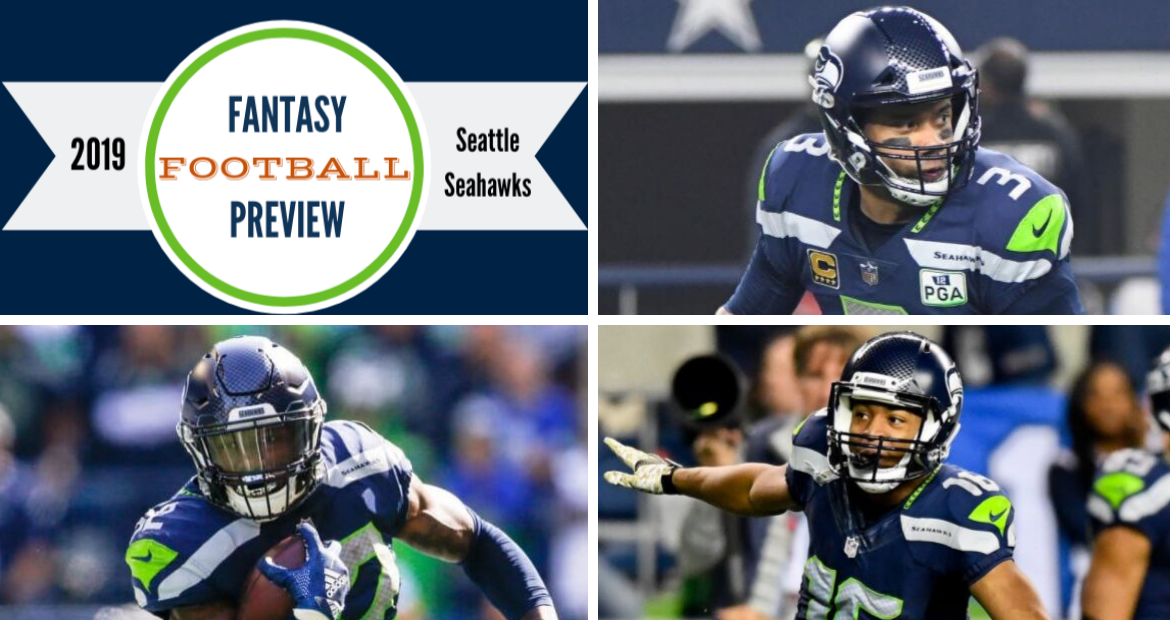
Fitz on Fantasy: 2019 Seattle Seahawks Buying Guide
With the training camp here, TFG fantasy expert Pat Fitzmaurice is breaking down the prospects for all 32 teams. Click here for a running list of teams, and check back often as teams are added on an almost daily basis. On to the Seattle Seahawks…
Russell Wilson is one of the most talented, most efficient, most elusive quarterbacks in the league. So why are the Seahawks’ game planers so hell-bent on tying his hands?
No, wait. “Tying his hands” doesn’t adequately describe it. Last year they handcuffed Wilson, wrapped a straitjacket around him and dropped him into a tank of water. A master illusionist, Wilson somehow managed to wiggle out of his bindings and escape with a QB9 fantasy ranking despite finishing 20th in pass attempts.
Wilson threw 427 passes last season. In 2017, he threw 553 passes and led all quarterbacks in fantasy scoring. He was also a top-three fantasy QB in 2014 and 2015 despite finishing 19th and 17th, respectively, in pass attempts. The man doesn’t need to be in a pass-happy offense to score points, but ideally he wouldn’t be quarterbacking an offense from the 1940s.
Figuring out how to treat Wilson in fantasy drafts is tricky. Does he get at least a dead-cat bounce in passing volume? The Seahawks have made it clear they want to run the ball as aggressively as Pete Carroll chews gum. Under Carroll and offensive coordinator Brian Schottenheimer – son of former NFL head coach Marty Schottenheimer, whose offensive conservatism was dubbed “Marty Ball” – the Seahawks were the only team in the league that ran more than they passed last year, running on 52.4% of their plays.
Wilson is going to be an efficient passer. He always is. But at age 30, his rushing production seems to be slowing down. He ran for 849 yards and six TDs in 2014 but has never come close to matching those rushing numbers. He had 586 rushing yards and three TD runs in 2017. Last year he ran for 376 yards and didn’t run for a single touchdown.
Mea culpa: I’m a University of Wisconsin guy, so it’s fair to regard my ranking of Russ with suspicion. In his lone season in Madison (he was a graduate transfer from North Carolina State), Wilson had the fifth most efficient season by a passer in college football history and led the Badgers to the Big Ten championship and the Rose Bowl (where they lost a 45-38 shootout against Oregon). Hence I tend to be in the “Russ will find a way” camp. But I know that Carroll and Schottenheimer are ready to throw pails of water on my campfire. I have Wilson ranked QB6, for what it’s worth.
Let’s take a moment to pour one out for WR Doug Baldwin, who retired after enduring a grim litany of injuries last year. After four unremarkable seasons, Baldwin exploded for 14 touchdowns in 2015 and provided dependable value for the next two years. He wasn’t drafted as highly as he deserved in those years, probably because his name is “Doug Baldwin.” Someday, an ambitious fantasy writer (not me – too lazy) will conduct a study showing that plain-named players provided a better return on investment than players with colorful names. But I digress.
With Baldwin gone, Tyler Lockett ostensibly becomes Seattle’s No. 1 receiver. Lockett turned 10 of his 57 receptions into touchdowns last year, had a catch rate of 81.4% and averaged an outlandish 14.85 yards per target (which was 2.55 yards more than his next-closest pursuer, Robert Foster). That sort of efficiency is unrepeatable – duh – but the anticipated boost in targets should help offset more earthbound rate stats.
How big will that target bump be, though? What sort of target load should we expect for a dude who’s 5-10, 182 pounds, and had a compound leg fracture in 2016? Also, doesn’t Russ usually spread the ball around? And what if one (or more) of the young wide receivers turns out to be really good?
Lockett has and ADP of WR22, and I have him at WR20 simply because that feels like the right place to put him. (I have no confidence in any stats projections for Lockett this year.) Truth be told, I’ve been drafting around him even though I think he’s a terrific ballplayer. There are just too many variables here for me to feel completely comfortable taking him.
Remember that pre-draft photo of D.K. Metcalf where he looked like something out of Marvel Comics? His body fat was purportedly measured at under 2%, which according to some sources would fail to support essential organ functions and put his well-being in jeopardy. Even if that measurement was bogus (it was), can a wide receiver that swole run away from lithe NFL cornerbacks?
Maybe he can. Metcalf’s 40-yard dash was timed at 4.33 seconds at the Combine. He also had a vertical jump of 40.5 inches (third best among Combine WRs) and a broad jump of 134 inches (fifth best). All this for a guy who’s 6-3 and 229 pounds.
And yet Metcalf had slower times in the three-cone and shuttle drills at the Combine than Tom Brady had in 2000. Metcalf played only 21 games over three years at Ole Miss due to foot and neck injuries but scored 14 TDs and averaged 18.2 yards per catch.
Metcalf’s range of outcomes is massive. I *think* it will take at least a year to get his footing in the NFL, but who knows? As I mentioned in the Rams Buying Guide, strength loves certainty, weakness loves risk. If you know you’re overmatched in the draft room, Metcalf is a worthwhile gamble for you.
David Moore isn’t as interesting as Metcalf, but he’s still interesting. A 2017 seventh-round pick from East Central University in Ada, Oklahoma, Moore spent most of his first year on the practice squad, appearing in one game. After making some splashy plays in the preseason last year, he had 26 receptions and scored five TDs in the regular season, averaging 17.1 yards per catch.
I think Moore has better than a 50/50 chance to outscore Metcalf this year, though Metcalf should still be drafted ahead of Moore simply because Metcalf’s ceiling is that of a young Terrell Owens and Metcalf’s floor is more like that of a young T.J. Houshmandzadeh (also a seventh round pick).
In addition to Metcalf, Seattle drafted two other rookie receivers. Fourth-rounder Gary Jennings scored 13 TDs and averaged 17.0 yards per catch for West Virginia last year. The biggest complaint about him is that he doesn’t play to his 4.42 speed. Seventh-rounderJohn Ursua is only 5-9, 178 pounds, and is already 25 years old – he served a two-year mission for the Church of Jesus Christ of Latter-Day Saints – but had 89 catches for 1,343 yards and 16 TDs at Hawaii last year and has slot potential. Six-year veteran Jaron Brown is also in contention to earn a roster spot and continue to bore the hell out of us.
Seattle’s tight ends are unattractive fantasy assets for the most part. Will Dissly had a TD catch in each of his first two NFL games, then tore his patellar tendon in Week 4. It’s an injury that was a career-wrecker, and Dissly wasn’t an exciting fantasy prospect to begin with. Nick Vannett is just a guy. Ed Dickson just turned 32 – happy birthday, Ed – and holds little fantasy promise. The one guy to watch here is Jacob Hollister, a former undrafted free agent from Wyoming who had eight catches in two years with the Patriots. Hollister runs well and drew praise at OTAs.
Pete Carroll is big on intramural competition, so draft capital doesn’t mean as much as it does on some other teams when the Seahawks are making decisions about roster spots and playing time. Chris Carson was a seventh-round pick out of Oklahoma State in 2017. Rashaad Penny was a first-round pick out of San Diego State in 2018. Carson averaged 17.6 carries a game last season. Penny averaged 6.1 carries.
That’s not to say the roles couldn’t be reversed, but Carson is one tough alley cat. He started to seize control of the Seattle backfield early in the 2017 season but broke his leg in the late stages of a Sunday-night trouncing of the Colts. He came back good as new last year and ran for 1,151 yards and nine TDs in 14 games, finishing 14th among running backs in fantasy points per game (half-point PPR).
Carson’s ceiling is somewhat limited because he isn’t going to catch a lot of passes in this offense, and he’s destined to share work. But his floor is pretty high, too, since the Seahawks love Carson and they love to run the ball. He’s a solid buy at his ADP of RB28.
Even if Penny can’t overtake Carson for the starting role, there’s still a decent chance he’ll have stand-alone fantasy value because Mike Davis had 112 carries for Seattle last year and is now in Chicago. But Penny also has a chance to overtake Carson. Don’t forget: Carroll presides over as pure a meritocracy as you’ll find in the NFL.
Penny was a monster in college, rushing for 2,248 yards and 23 touchdowns in his final season for the Aztecs. At 5-11 and 220 pounds he has prototypical lead-back size and good speed. He showed well in his limited role last year, averaging 4.9 yards per carry. With Davis out of the picture, Penny will get a much better chance to show exactly what he can do.
Penny isn’t going that much later than Carson in drafts, and that’s probably the way it should be. With an ADP of RB33, the Penny buying window is wide open, and I intend to crawl through it in several leagues.
Oft-injured C.J. Prosise is the lead candidate for the third-down role, though that role seems to mean less in Seattle than in other places. His primary competition is rookie sixth-rounder Travis Homer, a fleet-footed prospect from Miami.
| PLAYER | FITZ RANK | ECR | ADP | ADVICE |
| Russell Wilson | QB6 | QB7 | QB8 | Leap of faith |
| Chris Carson | RB26 | RB25 | RB28 | Decent buy |
| Rashaad Penny | RB31 | RB33 | RB33 | Buy |
| Tyler Lockett | WR20 | WR21 | WR22 | Tread lightly |
| D.K. Metcalf | WR53 | WR60 | WR48 | Caution |
| David Moore | WR58 | WR69 | WR88 | Dart throw |
| Will Dissly | TE40 | TE36 | TE31 | Pass |
ADP = Average Draft Position ECR = Expert Consensus Ranking (based on half-PPR scoring)



